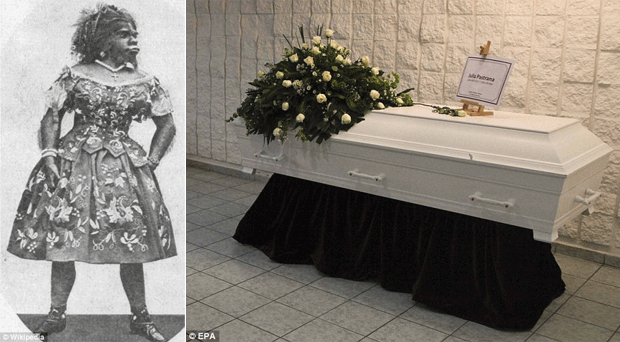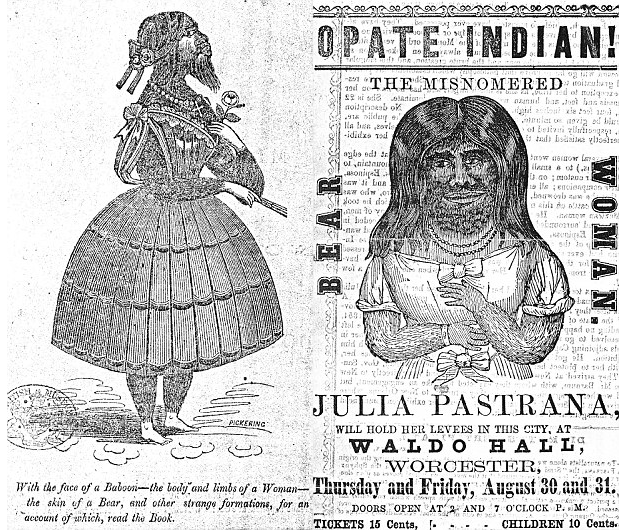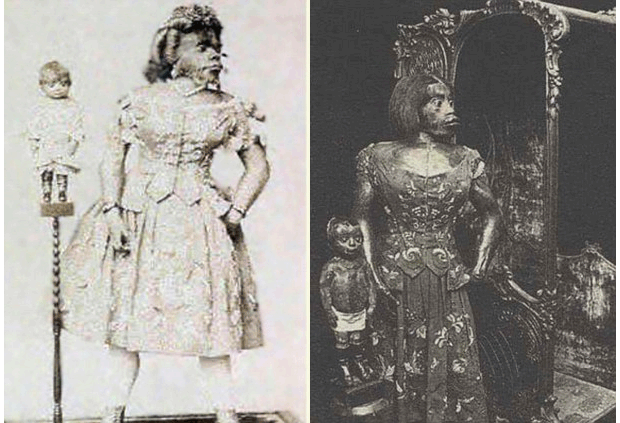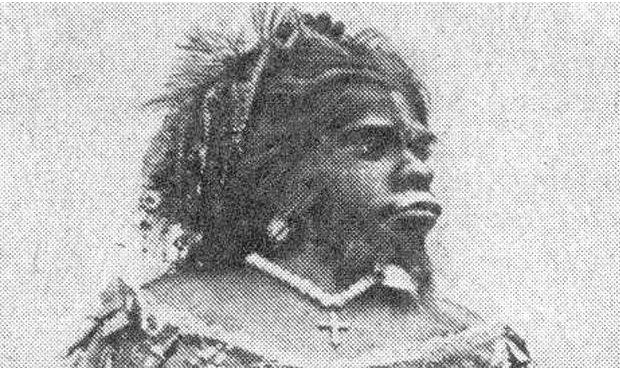|
A woman branded the 'ugliest woman in the world'
after a rare disease left her body covered in hair has finally returned
to her birthplace in Mexico for a proper burial - 153 years after her
death.
Julia Pastrana was exploited as part of a traveling exhibition through
Europe until she died from complications of childbirth in 1860. Even
after her death, her body was exhibited across the world.
|
 |
It eventually ended up in a storage room at an Oslo research institute,
and after learning of the body's whereabouts, visual artist Laura
Anderson Barbata campaigned to have it returned to Mexico.
'I felt she deserved the right to regain her dignity and her place in
history, and in the world's memory,' Barbata, who learned Pastrana's
story while working on a play about her life, told the New York Times.
'I hoped to help change her position as a victim to one where she can be
seen in her entirety and complexity.'
Barbata, who lives in New York but hails from Mexico City, eventually
won her decade-long battle and on Tuesday, Pastrana's body will finally
be buried in Sinaloa de Leyva.
Pastrana was born in Mexico in 1834 and suffered from congenital
terminal hypertrichosis, which left her face and body covered in thick
hair.
|
 |
She also suffered from gingival hyperplasia, which made her lips and
gums thick. She was not diagnosed with either condition in her lifetime.
In 1854, she was bought by a Mexican customs administrator and he began
exhibiting her through the U.S. and Canada. While in New York, she
married Theodore Lent, who became her manager.
Historians believe that while she was in love with Lent, he only married
her to control her earnings, the New York Times reported.
Lent toured his wife, whom he called a 'bear woman', through Europe.
Critics called her 'revolting in the extreme' and doctors said she was
the result a human mating with an 'Orang Outang'.
But she is also documented in 19th century history books as having an
affinity for singing, music, dancing and languages, as well as great
generosity to local charities.
|
 |
In 1859, she fell pregnant and her son inherited her hypertrichosis and
died 35 hours after his birth. Pastrana died from complications of the
birth five days later - aged just 26.
But the death did not stop Lent, and he began exhibiting his wife and
son's embalmed bodies propped up a in glass cabinet.
He later married a bearded woman in Mexico and billed her as Pastrana's
sister 'Zenora Pastrana'.
After his death in a Russian mental institution in 1884, the bodies
continued to be featured at exhibitions until thieves broke into a
warehouse owned by a fairground in Norway in 1976 and stole them.
The remains were later found by police in a trash bin; Pastrana's arm
had been dismembered and her son's body could not be salvaged.
In 1996, her body was taken to the Institute of Forensic Medicine at the
University of Oslo, where she was placed in storage.
|
 |
'By ending up as part of a collection in a basement, she lost any trace
of dignity,' Barbata said. 'My ultimate dream goal was that she should
go back to Mexico and be buried.'
Barbata learned of Padtrana's sad resting place while designing costumes
for a play her sister, Kathleen Anderson Culebro, produced in Texas: The
True History of the Tragic Life and Triumphant Death of Julia Pastrana,
the Ugliest Woman in the World.
In 2005, she began petitioning the University of Oslo to return the body
to Mexico, and in 2008, she made her case to Norway’s National Committee
for the Evaluation of Research on Human Remains.
In June last year, they agreed 'it seems quite unlikely that Julia
Pastrana would have wanted her body to remain a specimen in an
anatomical collection'.
The current governor of Sinaloa, Mario López Valdez, then joined the
cause last year, and the Mexican ambassador to Norway, Martha Bárcena
Coqui, offered to work with the university.
The institute agreed to start the process transferring the body to
Mexican custody last August, and last week, Barbata confirmed Pastrana's
identity before her coffin was sealed.
During the check, she saw that bolts remained in Pastrana's feet, and
they were removed.
Pastrana will be buried on Tuesday in a cemetery in Sinaloa de Leyva,
near to her birthplace. |